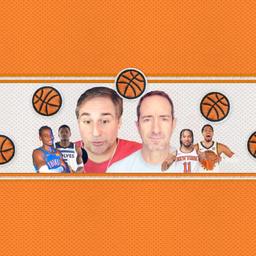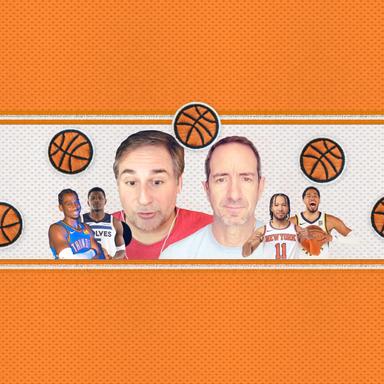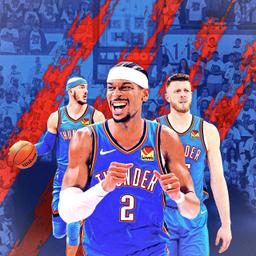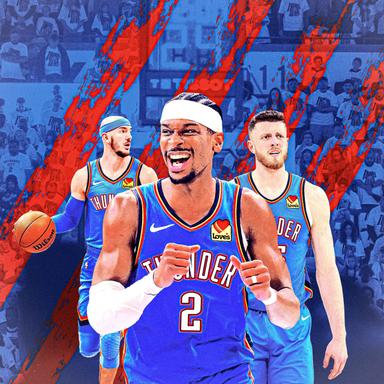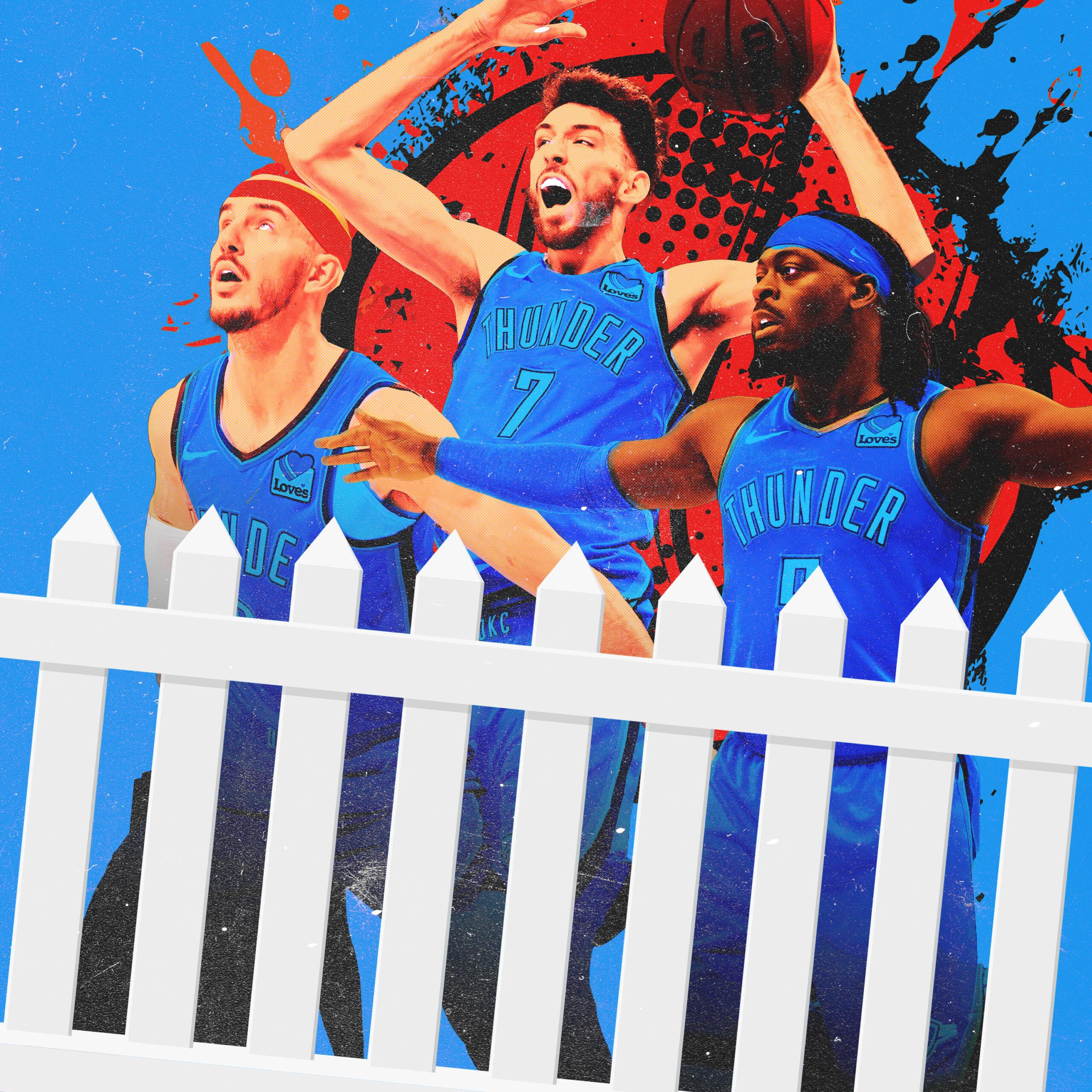
The epic second-round series between the Denver Nuggets and Oklahoma City Thunder was billed as an MVP duel between SGA and the Joker. In reality, the most important battle was that of a beautiful offensive force facing off against the dark arts of a dominant defense.
Nikola Jokic is the best offensive player in the world, but even his talents were not enough to steal Game 7 in OKC. After a tight start, the Thunder flexed their defensive muscle late in the first half, repeatedly stealing the ball and turning Denver miscues into points on the other end. Over 48 minutes, the Thunder forced 22 turnovers and held the Nuggets to just 39 percent shooting in a 125-93 win that punched OKC’s ticket to the Western Conference finals.
“Defense wins championships.” It’s a cliché that became a mockable mantra down in Dallas this season—but 400 miles north on I-35, this old saying is no laughing matter. In Oklahoma City, it might actually be true. OKC led the NBA in defensive efficiency by a wide margin in 2024-25. Defense is the team-building beacon Sam Presti was steering toward when he traded for Alex Caruso and signed Isaiah Hartenstein last offseason. And it’s the biggest reason OKC won 68 games and now finds itself within eight wins of its first NBA title.
This is not new for Presti. The longtime Thunder general manager cut his teeth as a member of the San Antonio front office and was part of the 2003, 2005, and 2007 Spurs title teams—those so-called “boring” defensive juggernauts that ended the Kobe-Shaq Lakers dynasty of the early 2000s before knocking out the “Seven Seconds or Less” Suns three times in four years. Now, nearly two decades since the end of his run with the Spurs, Presti has built a defensive juggernaut fit for the modern era—a swarming ensemble of pests, rebounders, and rim protectors tailored to stifle the best offenses and claw back some power against the high-powered attacks of the post-3-point-boom NBA.
Interior Domination
Early in the first quarter of Game 6 of the Western Conference semifinals, Christian Braun set a routine screen for Jokic near the top of the arc. Jokic took a single hard dribble to his right and saw Hartenstein and Shai Gilgeous-Alexander get tangled between roles and react a beat too late. Braun noticed immediately and darted toward the rim. With SGA a step behind, Jokic fired his water polo cannon with perfect timing and terrifying precision. The dime hit Braun in full stride—he caught it and rose up without hesitation. He’d finished plays exactly like this many times before, just the sort of sequence that made the Jokic-Braun pairing the most prolific passer–layup shooter combo in the entire league this season.
But this time around, the Nuggets had a problem. Chet Holmgren, OKC’s best help defender and maybe the best low man in the NBA right now, was lurking between the corner and the right block. As Jokic’s pass landed in Braun’s hands, Holmgren sprang into action. He met Braun at the mountaintop and rejected his layup attempt. Denver had counted on buckets like this all season long, but OKC has counted on denying them. Braun, who ranked ninth this season in total layups made, found out the hard way.
Holmgren was born for this. His length is absurd. Holmgren’s slight stature can be a limitation in one-on-one situations against bigger players, but his knack for help defense is unbelievable for someone who turned 23 earlier this month. Take this for data: Holmgren ranked first in field goal percentage allowed out of 148 players who defended at least 200 layup and dunk attempts this season. Better than Victor Wembanyama. Better than Rudy Gobert, too.
Opponents converted a minuscule 45.2 percent of their layups and dunks when Holmgren was the closest defender. The league average is over 61 percent.
During the regular season, Jokic and the Nuggets put up one of the strangest offensive profiles in the Association. They took fewer 3s than everyone else, yet they ended up with a top-five offensive rating. How? Denver was both the most prolific interior scoring team and the most productive transition outfit in the NBA. Simply put, layups in both the half court and transition were Denver’s oxygen.
On the flip side, the Thunder have the best interior defense and the best transition defense in the league, and their triumph in the war against Jokic and the Nuggets ultimately came because they won the battles in these two vital categories.
Over the series’ seven games, the exact layups that Denver depended on all year to fuel its offensive efficiency went away. The Thunder’s young guards and wings took away transition opportunities and drives, while their giant frontcourt of Holmgren and Hartenstein protected the rim. Look at the chasm between Denver’s layups and dunks during the regular season and against OKC in the conference semis:
Denver Nuggets Per-Game Layup Stats, Regular Season Vs. Round 2
Denver ranked first in the NBA in scoring at the rim in the regular season; it ranked last among the eight quarterfinalists in this same category. What happened? The Nuggets ran into the single most dominant force in the NBA right now. One sign of a great NBA defense is the ability to contain an opponent’s signature strength, but what the Thunder just did to Denver went beyond that—they just turned a great offensive team’s signature strength into a weakness.
This is a marked transformation from last season. In the 2024 playoffs, the Thunder lost in Round 2 to Dallas in part because they were too small—the Mavericks won on the glass, with points in the paint, and with second-chance opportunities, key weaknesses that Presti needed to address in the offseason.
In July 2024, Presti delivered by signing Hartenstein to a three-year deal. The results speak for themselves. With Hartenstein playing major minutes, OKC dominated the paint against the league’s best paint-scoring team. Hartenstein not only makes the Thunder’s frontcourt bigger and stronger, but he also frees up Holmgren to do what he does best: terrify opposing shooters as one of the league’s most devastating help defenders.
Perimeter Thievery
There have been a lot of great defenses that made their bones preventing shots at the rim, but what makes OKC’s defense even more special is the breadth of its excellence. They aren’t just great at one facet—in addition to shutting off the rim, the Thunder have arguably the best perimeter defense in the league.
The Thunder logged a staggering 74 steals in the seven games against Denver in Round 2. That’s the most in a single playoff series in at least 30 years. To put away Denver, OKC’s fleet of perimeter fiends logged 16 steals in Game 7 alone—the most by any team in a Game 7 since the Lakers in 1977.
We haven’t seen a set of ball hounds like this in the modern game, and turning defense into offense with steals is a big reason OKC’s offense is as efficient as it is. Steals not only end a possession for your opponent, but they also often launch a fast break for your own team. This effect was on full display as OKC opened up its big lead in the second quarter of Game 7. Right after Jamal Murray cut the lead to one, 42-41, with 3:11 left in the second quarter, OKC’s defense went on a bender, logging three steals in the final three minutes, ending the half on a killer 18-5 run.
That’s typical work for OKC, whose 10.3 steals per game this season led the league. The Thunder feast on live-ball turnovers, turning them into transition opportunities that then fuel their offense. In the 2025 playoffs, OKC is averaging 24.7 points per game off turnovers—that’s more than the scoring averages of Stephen Curry and Jamal Murray in this postseason, and it’s on pace to be the most in a single postseason by any team since these numbers were first tracked in 1997.
OKC’s havoc-wreaking defensive system is made possible in large part by its depth. The Thunder were one of the deepest teams in the Association last season, before they added Hartenstein and Caruso. Now, Presti has an embarrassment of defensive riches. Virtually every player on the Thunder roster is a thief. There is no weak link on the edge. Five different Thunder players averaged at least one steal per game during the regular season—Cason Wallace, SGA, Caruso, Jalen Williams, and Lu Dort. You know you are deep on defense when Dort ranks fifth on your team in steals per game, at 1.1.
That depth manifests as more than just fresh legs. It creates optionality. The deepest roster in the league enables coach Mark Daigneault to not only play the kind of aggressive defense that would wear most teams out but also toggle different schemes and matchups, like putting Caruso on Jokic in Game 7. Daigneault can choose between double-big lineups with Holmgren and Hartenstein or five-out lineups with Chet manning the middle, which may be more tenable now that the Thunder are through with Jokic.
Looking ahead to the conference finals, Minnesota hasn’t exactly been careful with the basketball lately. In the final three games of the series against the Warriors, the Timberwolves coughed up 63 turnovers—that’s not great, and if they don’t clean that up, you can bet the Thunder will be pouring in fast-break points once again.
Much like the OKC-Denver series was framed as a matchup between the two top MVP candidates, many are bound to view Thunder-Wolves as SGA versus Ant-Man, but that’s only part of the story. The biggest question is how Anthony Edwards and the rest of the Timberwolves will respond to Oklahoma City’s pressure.
Defense may not go viral. It may not lead First Take or talk radio segments. It doesn’t even sell popcorn. So what does defense do? Ask Nico Harrison.

